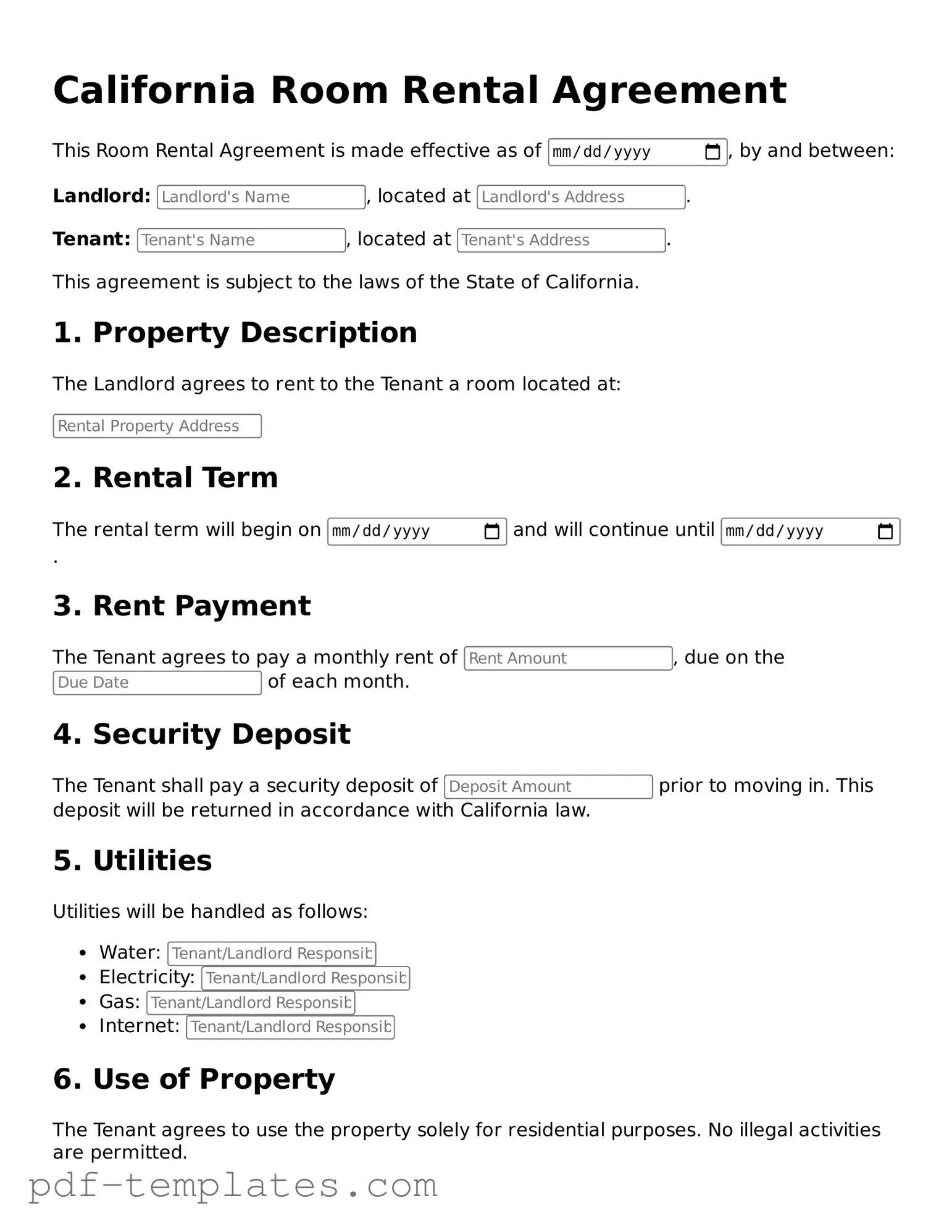The California Room Rental Agreement form shares similarities with the Residential Lease Agreement. Both documents outline the terms and conditions under which a tenant can occupy a property. They typically include details about the rental amount, duration of the lease, and responsibilities of both parties. While a Room Rental Agreement often pertains to a single room within a larger dwelling, a Residential Lease Agreement usually covers an entire apartment or house. This distinction is important as it affects the rights and obligations of the tenant and landlord.
Another document that resembles the Room Rental Agreement is the Sublease Agreement. This agreement allows a tenant to rent out their leased space to another person. Like the Room Rental Agreement, it specifies the rental terms, duration, and conditions of occupancy. The key difference lies in the relationship between the parties involved; in a sublease, the original tenant remains responsible to the landlord, whereas in a room rental, the landlord directly contracts with the room renter.
The Lease Option Agreement is also akin to the Room Rental Agreement. This document provides a tenant with the option to purchase the property at a later date. While it primarily focuses on the potential sale, it also includes rental terms during the lease period. Both agreements detail payment obligations and maintenance responsibilities, but the Lease Option Agreement introduces an additional layer of complexity by incorporating a future purchase option.
In addition to these agreements, professionals in the beauty industry in California must be aware of the Cosmetology License Renewal California form, which is essential for maintaining their licenses. This form requires detailed personal information and, similar to rental agreements, highlights the importance of adherence to regulations. To ensure compliance and avoid working with an expired license, it is crucial to submit the form along with the necessary fees promptly. For more details and resources, refer to All California Forms.
In addition, the Month-to-Month Rental Agreement bears similarities to the Room Rental Agreement. This type of agreement allows for more flexibility in the rental terms, as it can be terminated with short notice. Like the Room Rental Agreement, it outlines rental amounts and responsibilities but differs in its duration, as it does not commit the tenant to a long-term lease. This flexibility can be appealing for those who may not want to commit to a lengthy stay.
The Furnished Rental Agreement is another document that aligns closely with the Room Rental Agreement. It typically includes terms for renting a property that comes with furniture and other amenities. Both agreements specify the rental terms, security deposits, and maintenance responsibilities. The key distinction is that a Furnished Rental Agreement usually requires the landlord to provide furnishings, which can affect the rental price and the tenant's obligations regarding the care of those items.
The Commercial Lease Agreement is also relevant, particularly for those renting space for business purposes. While it is primarily designed for commercial properties, it shares fundamental elements with the Room Rental Agreement, such as defining the rental amount and duration. Both agreements protect the rights of the tenant and landlord, though the Commercial Lease often includes clauses that address business operations, which are not typically found in residential agreements.
Finally, the Lease Agreement for Shared Housing is similar to the Room Rental Agreement in that it governs the terms of renting a room within a shared living environment. Both documents outline responsibilities, payment terms, and conditions for common areas. The shared housing lease often includes additional provisions regarding shared responsibilities, which can make it more complex than a standard Room Rental Agreement, but the foundational elements remain consistent.
